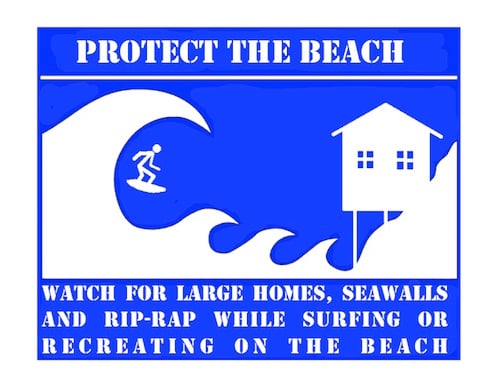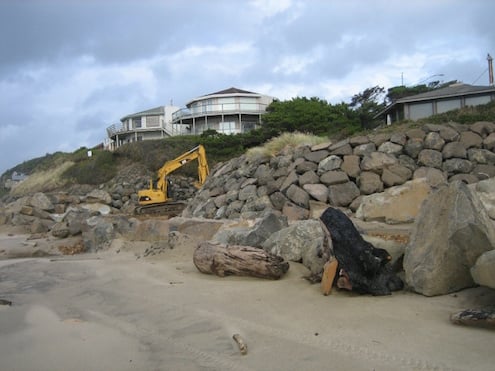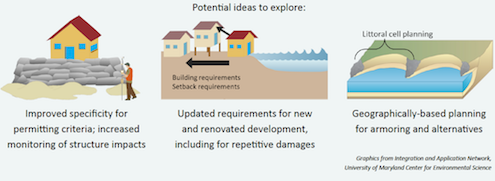
08.03.16
Shifting Sands: Oregon Analyzes Policies on Beach Preservation and Coastal Armoring
By Charlie PlybonEach El Nino year that passes, the Oregon coast, most importantly our beaches and dunes, suffer increased susceptibility to storm activity and erosion. Dune and cliff erosion, when in concert with coastal development are too often met with Trump-like wall building solutions (a.k.a "coastal armoring") to hold back mother nature, but can rob the public's beaches of sand and potentially access to the beach altogether. On the hand, where sand leaves one location it often piles in another, eliciting equal responses of dune grading and sand-removal, often without a permit. These combined actions and responses to erosion are not only contrary to Oregon's famed Beach Bill, but they threaten the very existence of our beaches. From 2013-2015, Oregon state agencies worked with a NOAA Coastal Fellow to perform an inventory of coastal armoring along our coast and analysis of the current and potential future policies for managing our beaches and dunes.
 Will we make recreational trade-offs to manage Oregon beaches for homeowners, or will we manage Oregon beaches for recreation?
Will we make recreational trade-offs to manage Oregon beaches for homeowners, or will we manage Oregon beaches for recreation?
As we approach the 5oth Anniversary of Oregon's famed 1967 Beach Bill, the landmark legislation establishing public ownership of our beaches, taking a fresh look at the status of our beach and dune management in the interest of this public birthright is imperative for Surfrider Foundation. Surfrider was founded on the principle that our beaches, oceans and waves are for everyone to enjoy and as such should be managed within the public trust. Oregon feels like home for this part Surfrider's mission, our statewide policy on beaches clearly favors public interests over that of the private/corporate developer or industry. Further, statewide planning goals, such as Goal 18, give direction to local jurisdictions to protect these public interests through their coastal planning efforts. But with each El Nino year, these policies get relaxed. Coastal armoring such as rip rap gets permitted under "emergency" situations when wealthy homeowners pout, and rock after rock gets piled out onto what are supposed to be our public beaches.
 Rocks are piled high (rip rap) to protect homes in Gleneden beach, but beachgoers won't find much (if any) beach to walk on at high tide these days
Rocks are piled high (rip rap) to protect homes in Gleneden beach, but beachgoers won't find much (if any) beach to walk on at high tide these days
Decisions such as slacking up on Goal 18 in coastal planning, "emergency" armoring and dune grading slowly but surely erode our public beaches. The sands of politics shift with each season from the public to the beachfront property owner...and Oregon's managing agencies are facing the trade-offs of our birthright resources. Thus, in 2015 Meg Gardner, a NOAA Coastal Fellow working with Oregon Coastal Management Program and Oregon Parks & Recreation Department, produced a poster Oregon's Eroding Coastline: Seeking Solutions in the Face of a Changing Climate. The poster illustrates a logical process to address coastal erosion hazards and is intended to assist in initiating an informed conversation on potential policy changes to manage these hazards.

Gardner's final report can be downloaded here: Analysis of Shoreline Armoring & Erosion Policies Along the Oregon Coast. The report analyzes and integrates current public policy regarding coastal erosion and shoreline armoring with the latest relevant geospatial and natural science information (including predicted impacts of climate change), in order to understand the most vulnerable coastal areas. Policy ideas are also explored, from changing statewide policy related to beachfront protective structure permitting and eligibility requirements, to adopting new local land-use policies to regulate development in coastal hazard zones. Although state policies are generally regarded as effective at regulating shoreline armoring equitably and broadly along the coast, there may be instances where local government policy changes/planning or additions may be a more effective way to try to address some of the current policy challenges related to shoreline armoring and coastal erosion risks. Local efforts can be tailored to each jurisdiction and its unique geography and social context, and local efforts can be more restrictive than statewide policies. Several local policy ideas are explored in the Policy Ideas section of this report.
One thing is for certain, Oregon's coast is facing increased erosion, stronger storm activity, bigger wave heights and many other challenges related to climate change. We are entering our 50th year in celebrating the strongest public beach policy in the nation. The question in front of us is will we prevail in managing public beaches for the Oregon public to enjoy and recreate on for generations to come, or will we manage to "hold the line" for those precious coastal homes with an ocean view?
